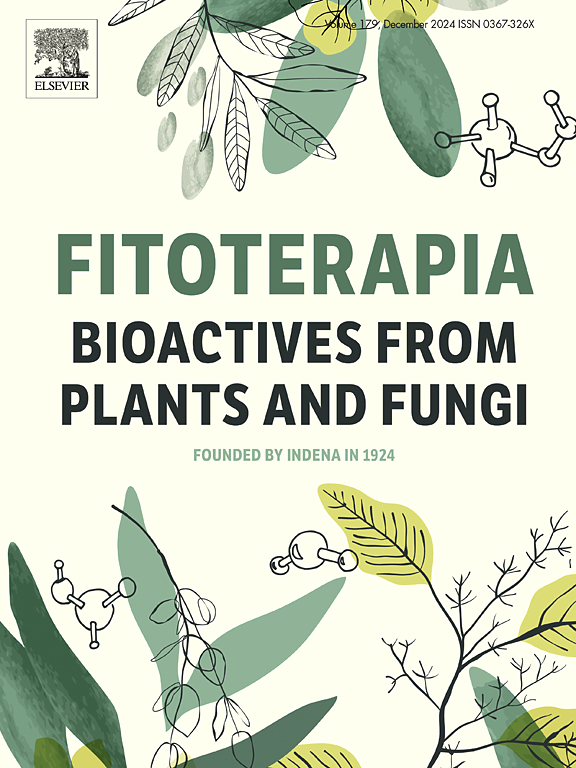药用植物 Peucedanum japonicum Thunberg:传统用途、植物化学和药理学综述。
IF 2.5
3区 医学
Q3 CHEMISTRY, MEDICINAL
引用次数: 0
摘要
Peucedanum japonicum(伞形科)是一种多年生草本植物,具有治疗咳嗽、感冒、头痛和炎症反应的各种重要传统价值。为了开发药物,目前的研究旨在从传统用途、植物化学、药理价值和分子机制三个主要方面概述有关该药用植物的以往成果。通过色谱分析和分离,共分离出 120 多种化合物。主要的植物化学成分为黄柏酮类香豆素和酚类化合物,其中一些香豆素类化合物,如萼片香豆素、praerutorin A 和 pteryxin 是主要的代谢产物。日本鸦胆子成分的药理活性包括抗癌、抗氧化、抗菌、抗病毒、抗血小板和酪氨酸抑制活性,尤其是抗炎和抗肥胖活性。值得一提的是,所获得的成分还能保护神经元、骨骼和尿液系统,并起到舒张血管的作用。一般来说,抗炎作用的基本机制可通过丝裂原活化蛋白激酶/核因子-卡巴B(MAPK/NF-κB)信号通路来解释,而抗肥胖活性则可通过调节脂质代谢相关基因来推导。研究还指出,翼苷是活性最高的化合物,但临床研究和合成药用价值更高的新衍生物仍然有限,有待改进。本文章由计算机程序翻译,如有差异,请以英文原文为准。

The medicinal plant Peucedanum japonicum Thunberg: A review of traditional use, phytochemistry, and pharmacology
Peucedanum japonicum (the family Umbelliferae) is a perennial herbaceous plant with various crucial traditional values for coughs, colds, headaches, and inflammatory responses. For drug developments, the current research aims to offer an overview of the previous results in the three main aspects of traditional use, phytochemistry, pharmacological values, and molecular mechanisms regarding this medicinal species. By chromatographic analysis and separation, more than 120 isolated compounds have been obtained. Khellactone-type coumarins and phenolic compounds are the primary phytochemical classes with some coumarins, such as calipteryxin, praerutorin A, and pteryxin, being the main metabolites. Pharmacological activities of P. japonicum constituents included anticancer, antioxidative, antimicrobial, antiviral, antiplatelet, and tyrosine inhibitory activities, especially anti-inflammation and anti-obesity. It is worth mentioning that the obtained constituents joined to protect the neurons, bone, and urine systems, and exerted vasorelaxant. In general, the underlying mechanism of anti-inflammatory action can be explained by mitogen-activated protein kinase/nuclear factor-kappa B (MAPK/NF-κB) signaling pathway, whereas anti-obesity activity is deduced from regulating lipid metabolism-related genes. It also noted that pteryxin is the most active compound, but the clinical studies and synthesis of new derivatives containing enhanced medicinal values have been still limited, which should be improved.
求助全文
通过发布文献求助,成功后即可免费获取论文全文。
去求助
来源期刊

Fitoterapia
医学-药学
CiteScore
5.80
自引率
2.90%
发文量
198
审稿时长
1.5 months
期刊介绍:
Fitoterapia is a Journal dedicated to medicinal plants and to bioactive natural products of plant origin. It publishes original contributions in seven major areas:
1. Characterization of active ingredients of medicinal plants
2. Development of standardization method for bioactive plant extracts and natural products
3. Identification of bioactivity in plant extracts
4. Identification of targets and mechanism of activity of plant extracts
5. Production and genomic characterization of medicinal plants biomass
6. Chemistry and biochemistry of bioactive natural products of plant origin
7. Critical reviews of the historical, clinical and legal status of medicinal plants, and accounts on topical issues.
 求助内容:
求助内容: 应助结果提醒方式:
应助结果提醒方式:


